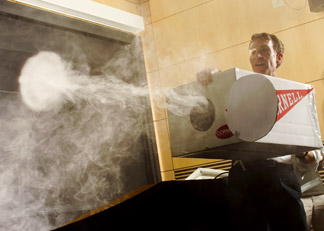The Science Guy says goodbye, but not without warning that the globe is 'getting really hot ... really fast'
By Lauren Gold

His stay included guest lectures in astronomy and human sexuality (not at the same time); an orbit around downtown Ithaca's Carl Sagan Planet Walk; lunch with prospective graduate students; and a public lecture March 8 titled "Everybody Talks About the Weather." Now Bill Nye's legion of admirers are left only with reruns of his Emmy Award-winning television show, "Bill Nye, The Science Guy" -- although he says he will return to the campus periodically.
Nye, a 1977 graduate of Cornell's Sibley School of Mechanical and Aerospace Engineering, made his last trip to campus as a Cornell University Frank H.T. Rhodes Class of '56 Professor March 6-11.
The weather, he told a packed crowd at Alice Statler Auditorium, is worth talking about. Take global warming. Few informed people would argue with the evidence of global climate change. But "warming" just doesn't sound, really, like a bad thing, he said, suggesting we should perhaps use different words.
Call it "global cooking," Nye suggested, or "really hot ... really fast." Even a modest change from "global warming" to "global heating" might spur people to action.
Climate change is not rocket science, he said. Last April -- four months before Hurricane Katrina -- he warned of the potential for a catastrophic 2005 hurricane season on TV news programs. "Am I a genius? No. I was just paying attention. And a lot of people aren't," he said.
Some evidence of global heating, he said, is found in ice core samples in a laboratory in Colorado and in carbon dioxide levels in the atmosphere. He showed the 2002 Intergovernmental Panel on Climate Change's "graph of death," which extrapolated three scenarios for rising global temperatures in the future.
He discussed the devastation of slash-and-burn logging and wasteful transportation choices. He noted that advocates of intelligent design and other nonscientific ideologies are most likely to distrust the evidence of global warming and argued for more emphasis on science education in schools.
To fellow and future Cornell alumni, Nye ended with a special appeal.
"It's such a big deal that it's hard for most people to get their minds around. You want to -- pun intended -- go with the flow," he said. "Don't. You guys are Cornellians. I want you to take a few seconds and realize you're part of this hopeful, wonderful legacy."
He showed an image of the Earth seen from space.
"I want everybody to take another few moments and look at this picture," he said. "Because it is this tiny, tiny world. Really, it is this perfect ball. ... And it's a sobering thought to realize that anyone who's ever lived -- every corporate pig, every do-gooder environmentalist, every somewhere-in-betweener -- has lived in this world. And it's not very big.
"There were 3 billion people in the year 1965; there are well over 6 billion now," he said. "And everybody's got to fit on here. We need more of these, and we've only got one -- so I encourage you every day to think about global heating. To think about your place in the world, and think about your legacy as Cornellians and -- dare I say it? -- change the world."
His message resonated. "I like Bill Nye. I think he's really funny. He makes science easy to understand and not boring, and at the same time he shows it's important," said Talia Belamy, a sophomore majoring in English, after the lecture.
Andrea Vidler, a sophomore in industrial and labor relations, agreed. "He makes me like science. He's funny. And when he says something, he definitely gets his message across."
Media Contact
Get Cornell news delivered right to your inbox.
Subscribe